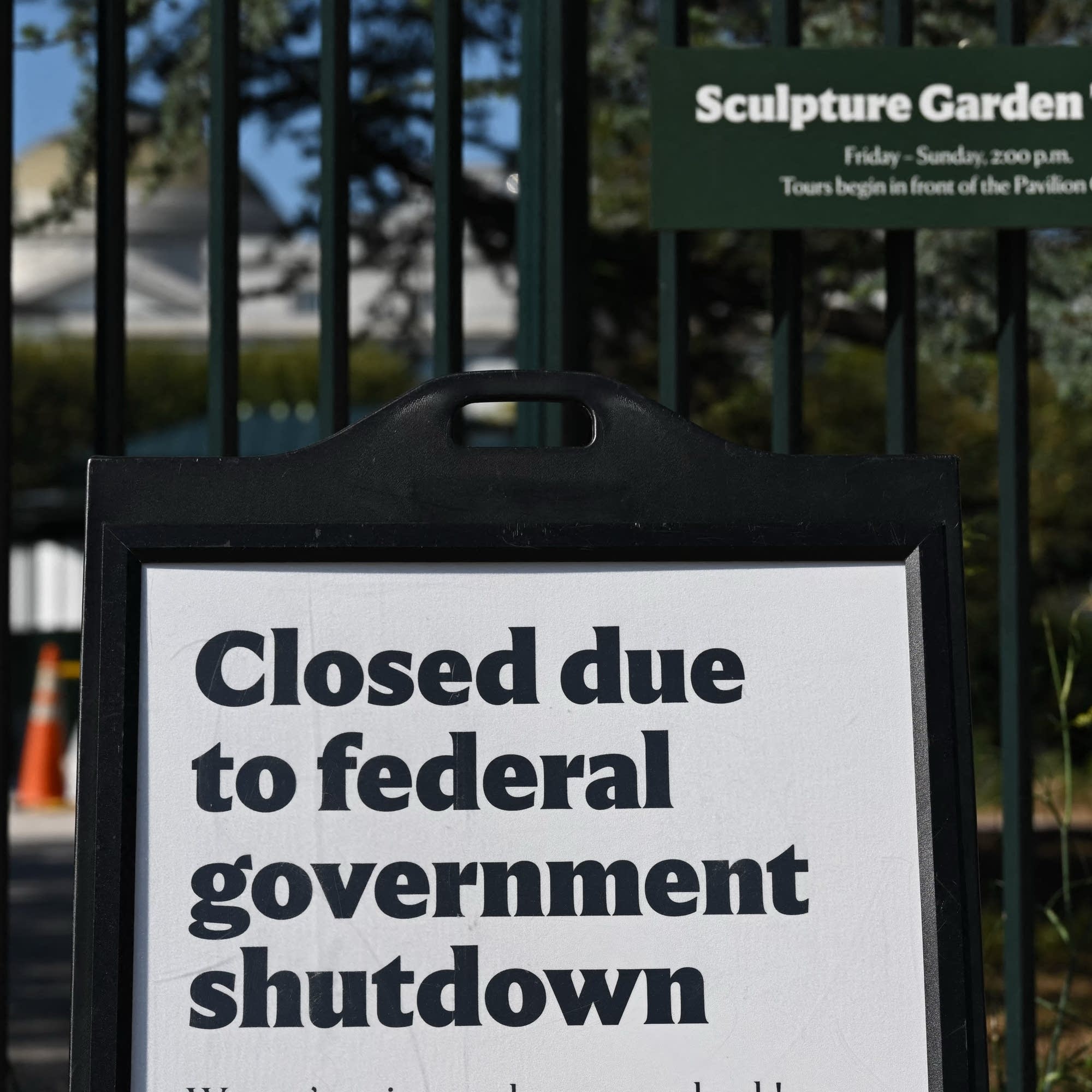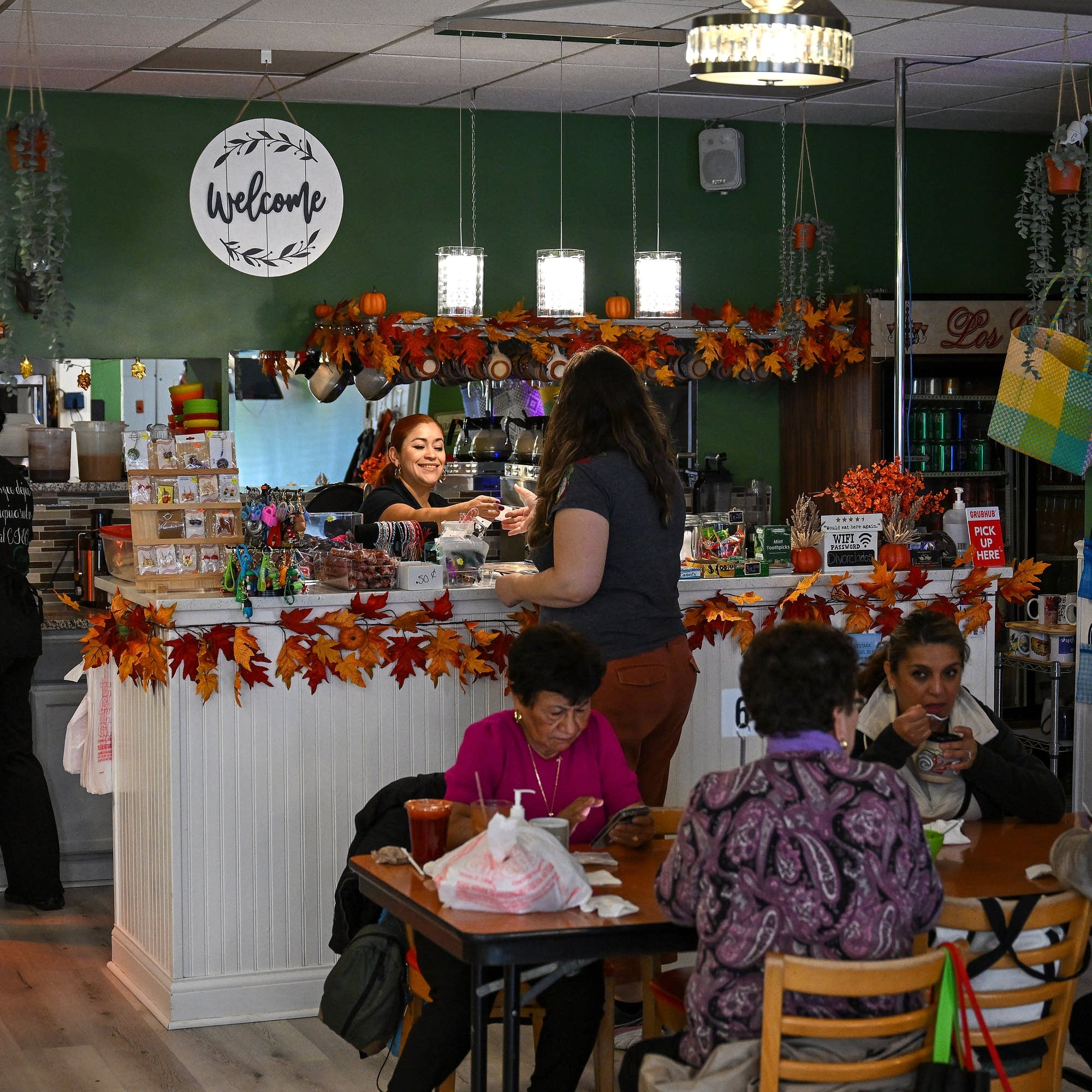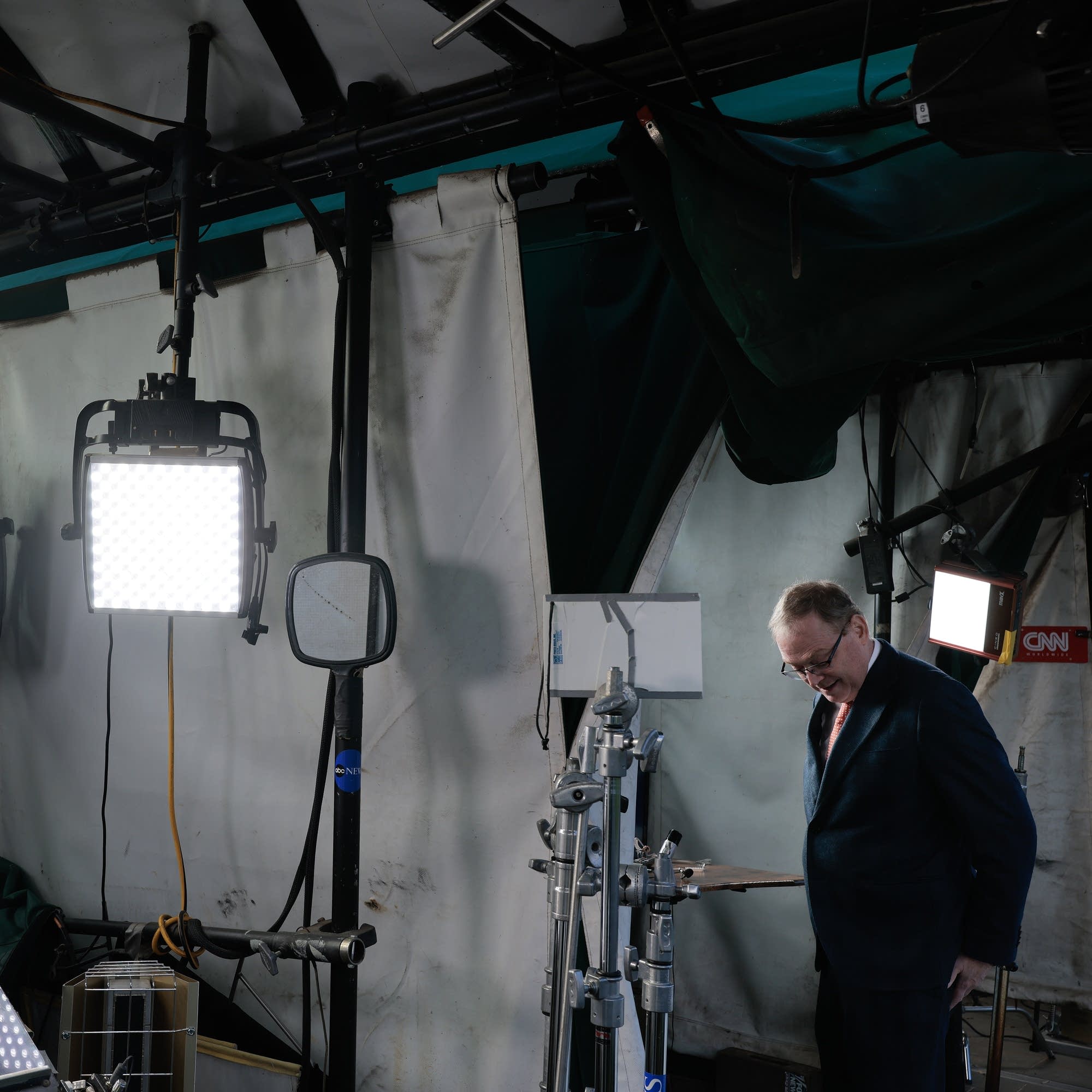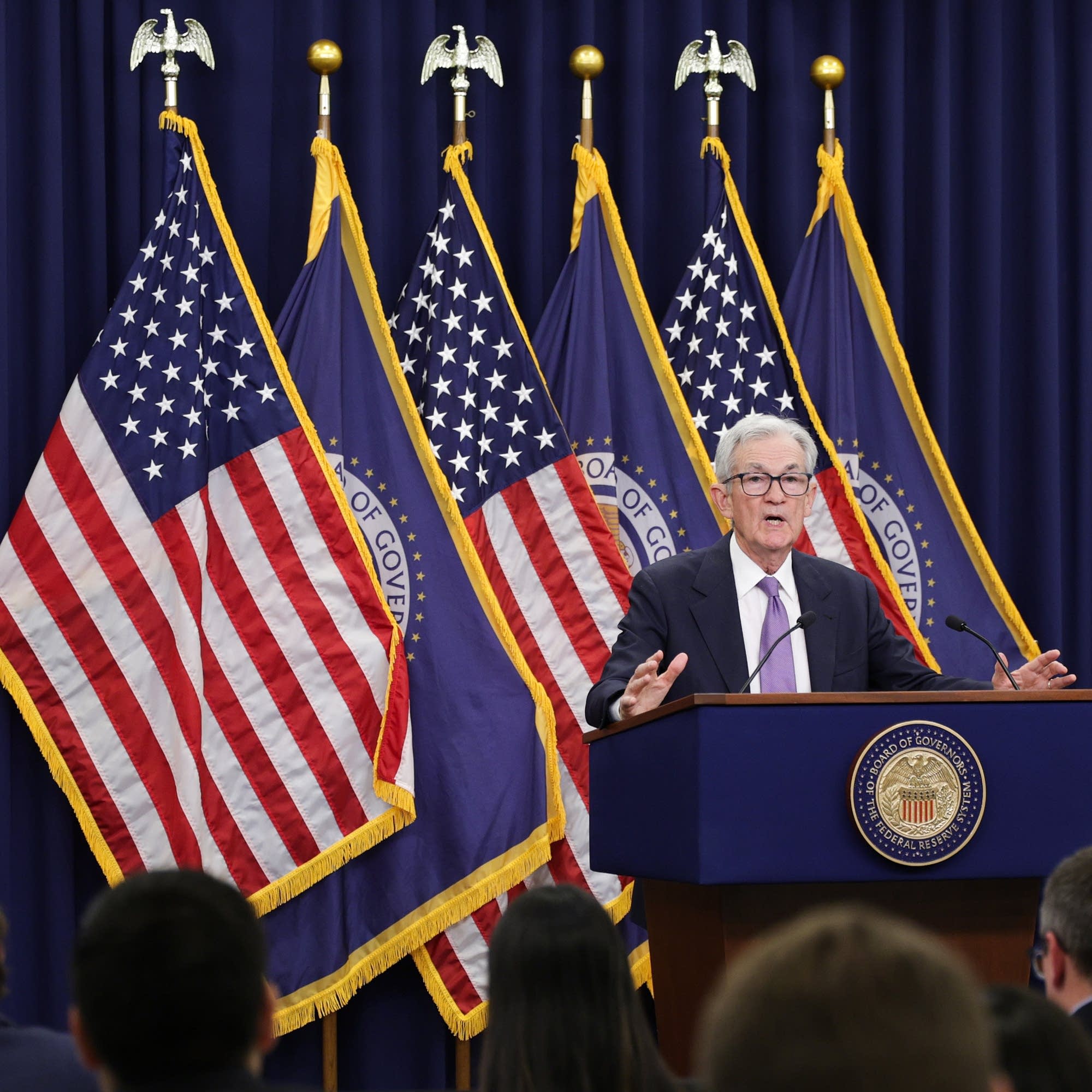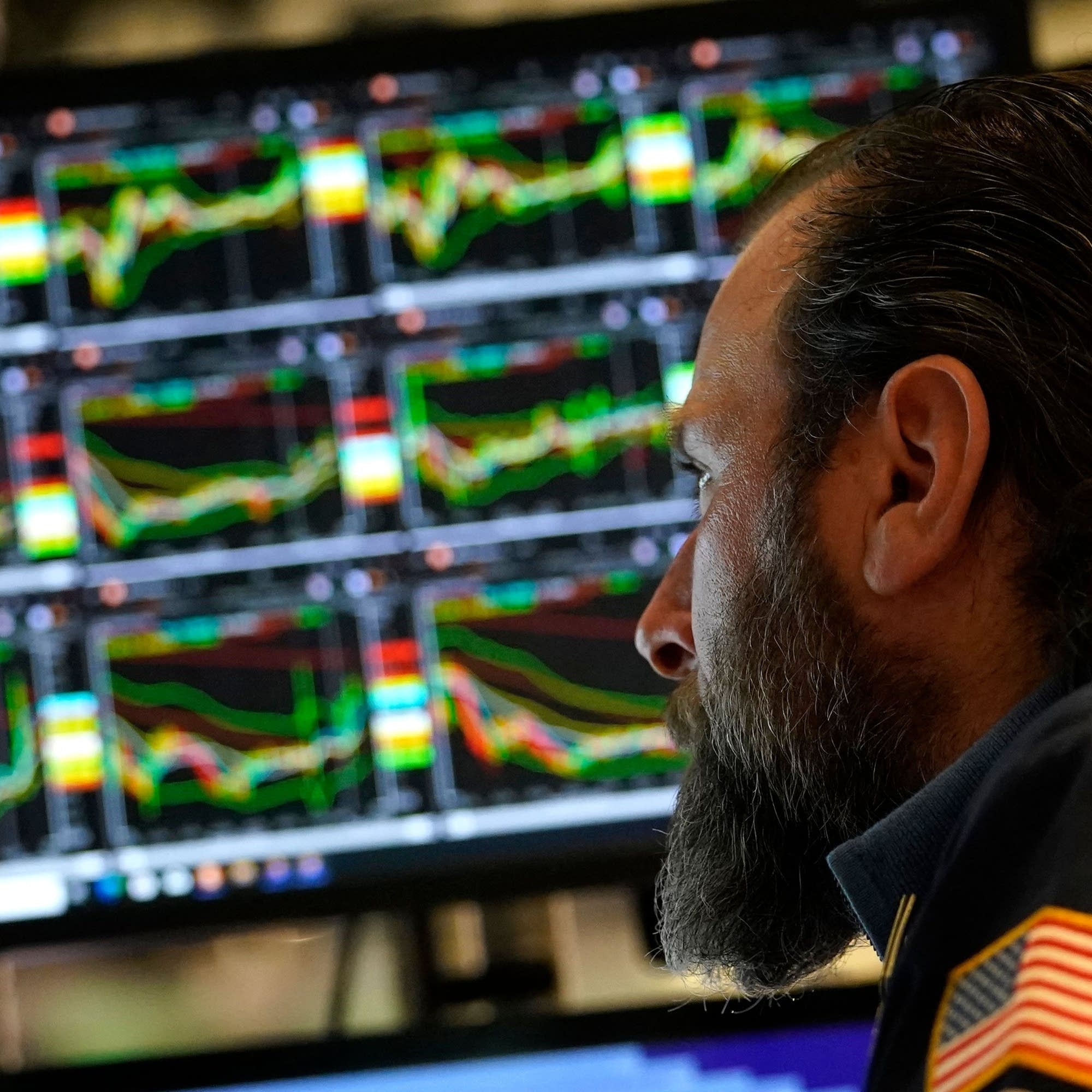Filling the federal data void
The federal government shutdown drags on this week, leaving a labor data vacuum. Private firms are hoping to fill the gap with their own data sets — some are even offering ‘em for free. Unfortunately, that private data is narrower and less comprehensive than typical BLS reports. Also in this episode: The popularity of all-cash home sales, the unique risks and boons AI presents for Indian Country, and the vital role of equipment auctions for small contractors.
Every story has an economic angle. Want some in your inbox? Subscribe to our daily or weekly newsletter.
Marketplace is more than a radio show. Check out our original reporting and financial literacy content at marketplace.org — and consider making an investment in our future.
Press play and read along
Transcript
Speaker 1 Went to Rome.
Speaker 2 I thought that my boyfriend was going to propose to me West High. I did use my Sapphire Reserve for the flights, so the points did make up for the whole no proposal.
Speaker 4
Earn 8 times points when booking for Chase Travel with Chase Sapphire Reserve. Now even more rewarding.
See more rewards at chase.com slash reserve.
Speaker 5 This podcast is supported by Odo. Some say Odo business management software is like fertilizer for businesses because the simple, efficient software promotes growth.
Speaker 5 Others say Odoo is like a magic beanstalk because it scales with you and is magically affordable.
Speaker 5 And some describe Odoo's programs for manufacturing, accounting, and more as building blocks for creating a custom software suite. So Odoo is fertilizer magic beanstock building blocks for business.
Speaker 5
Odoo, exactly what businesses need. Sign up at odo.com.
That's odoo.com.
Speaker 1 It's day seven of the government shutdown, which means we are solidly standing in a second business week without crucial federal data. From American Public Media, this is Marketplace.
Speaker 1
In New York, I'm Kristen Schwab in for ChirizDahl. It's Tuesday, October 7th.
Good to have you along. Economists and economic journalists need data.
Speaker 1
Numbers give us a sense of where the economy has been, where the economy is now, and where the economy is heading. But data, thankfully, come in many forms.
Today we got some from the private sector.
Speaker 1 The investment firm Carlisle released a report about employment in September.
Speaker 1 The company estimates that just 17,000 jobs were created last month, which, in the grand scheme of things, is pretty paltry.
Speaker 1 Carlisle is just one of many companies now providing this kind of data to the public. And because nothing is ever really free, why would a private firm just offer this up?
Speaker 1 Marketplace's Daniel Ackerman looked into it.
Speaker 8 Today's Carlisle report tells basically the same story we've been hearing from other data sources.
Speaker 9 A pretty consistent picture of really slow or stalled growth in the U.S. labor market.
Speaker 8 Celeste Cruthers is a labor economist at the University of Tennessee, and she says companies collect economic data in different ways.
Speaker 9 Carlisle from their investment holdings, ADP from payrolls.
Speaker 8 And because these firms are limited in how they're able to collect information, Elise Gould with the Economic Policy Institute takes these reports with a small grain of salt compared to the federal data.
Speaker 11 It's not that they're less trustworthy, it's that they don't provide the same kind of comprehensive picture month after month, year after year.
Speaker 8 Gould says the government data is just richer.
Speaker 11 We get very accurate information about demographics, so everything from race and gender to education level to where they live.
Speaker 8
Plus, the government is clear about how they collect all that information. Preston Muay of Employ America says not all private sector firms are so forthcoming.
For instance, the Carlisle report.
Speaker 12 It's hard to say exactly how seriously to take it because the details of exactly how they constructed the data were not really apparent. They just said that it was based on their proprietary data set.
Speaker 8 Carlisle didn't respond to an interview request. Muay says that private companies can provide some data sets that the government simply can't, even when it is up and running.
Speaker 12 One that I really like is the Indeed wage tracker, which looks at wage growth in job postings.
Speaker 8
As for why private firms would just publish this data for free, we do it as a public service. John Challenger is CEO of Challenger Gray and Christmas.
That's an out-placement firm.
Speaker 8 They help companies deal with layoffs, so they already collect that data.
Speaker 13 It's just the focus of what we do as a business. We look for trends by industry and region, so we work hard at trying to create solid information that comes out at the beginning of each month.
Speaker 8 Plus, it doesn't hurt that this kind of public service can also be good for business, says Gerald Cohen, an economist at the University of North Carolina.
Speaker 14 I think it's a bit of marketing.
Speaker 8 But Cohen says, with government data on hiatus, it's the best we've got. I'm Daniel Ackerman for Marketplace.
Speaker 1 Wall Street today, was it the shutdown? Was it rising gold prices? Whatever it was, traders did not like what they saw. We'll have the details when we do the numbers.
Speaker 1 We've done plenty of stories on the sticky housing market. Stories about high prices and high mortgage rates.
Speaker 1 Though rates have come down a bit in the last couple months, the average 30-year fixed is 6.34%,
Speaker 1
according to Freddie Mac. That's below the one-year average, but still plenty high for home buyers.
So many of them are skipping mortgages altogether.
Speaker 1 Almost a third of all homes sold in the first six months of the year went to buyers who made all cash offers, according to a report out today from Realtor.com.
Speaker 1 Marketplace's Carla Javier looks into who these buyers are and how they're impacting the housing market.
Speaker 15 Cash offers made sense back in the competitive pandemic housing market, says Hannah Jones at the National Association of Realtors.
Speaker 10 But now, you know, we're in the slightly less competitive housing market. And so it's interesting to see that, you know, cash share is still relatively high because it is also, it's this flag of,
Speaker 10 you know, investor activity to some degree. And it's also a flag of, you know, how much wealth is in the housing market right now.
Speaker 15 When it comes to cheaper homes, Jones says the cash buyers tend to be investors who either rent the place out or try to flip it for profit.
Speaker 10 It also could be buyers who maybe can't get approved for a mortgage and so they're looking to buy in all cash.
Speaker 15 But Jones says there's another group of all cash buyers making bids on more expensive homes. They tend to be wealthier, older, and they've owned homes before.
Speaker 10 There are households that are definitely in a situation where if they sell their home, they can buy their next home in all cash.
Speaker 15 And if they've been in their house long enough, gains in value might offset offset the cost of a new house, especially if they downsize or move somewhere more affordable.
Speaker 15 Paying in cash makes an offer more attractive to sellers. It also costs less for buyers.
Speaker 15 Michael Reher at the University of California, San Diego, found that out after he made a bid on a house backed by a mortgage right before the pandemic and lost out to an all-cash offer.
Speaker 15 So he and a fellow researcher looked at how much a difference cash made for the average buyer.
Speaker 12 If they were to switch from mortgage to cash, they could buy the same home for 10% less.
Speaker 15 One caveat though, that research was done before COVID.
Speaker 15 In the time since, Redfin chief economist Daryl Fairweather notes that the prevalence of cash offers reflects a market that's tough to break into.
Speaker 10 People who are first-time home buyers who don't have cash, who can only afford small down payments,
Speaker 10 it's been quite hard for them in this high interest rate environment.
Speaker 15 Because less cash means more risk for sellers that financing may fall through and the deal may fall apart. I'm Carla Javier from Marketplace.
Speaker 1 We can look at jobs and housing market data to tell us a lot about the economy.
Speaker 1 But sometimes squinting at super specific, dare I say niche data may tell us something else that the big, broad stuff can't.
Speaker 1 Sales of secondhand goods can explain what's happening in certain industries and with businesses and consumers.
Speaker 1 There's used cars, thrifted clothing, and as Marketplace's Matt Levin reports, construction equipment.
Speaker 14 It's a preview day at Bar Nun Auction Yard in Southeast Sacramento.
Speaker 14 The 18-acre dirt lot feels like a blend of well-organized junkyard and used car dealership, with 2,000-plus items set for online auction the next day from beat-up ambulances to portable saunas.
Speaker 16 Some stuff will come from government agencies.
Speaker 14 Jeff Huber is Bar Nunn's marketing head.
Speaker 16 The other piece is just individuals, corporations, businesses themselves, older equipment that they're looking to
Speaker 16 offload, maybe to make room for new stuff or maybe they just need to free up some cash.
Speaker 14 Huber is giving me a tour of the auction's biggest attractions, a stretch of the yard the Bar Nunn employees call Main Main Street.
Speaker 16 And you'll see right in front of us, we have a nice big wheel loader. Beyond that, we have a motor grader, then we have a nice big excavator, then we got some mini X's.
Speaker 14 Rows upon rows of heavy construction equipment, lots of Caterpillar and John Deere logos.
Speaker 14 Hubert walks me to a skid steer, kind of an all-terrain bobcat type thing, and he's not sure it's gonna start up.
Speaker 16 Now, some things will be
Speaker 15 dead.
Speaker 14 We're in luck.
Speaker 16 So like if you were to come out and you were to turn the key and nothing happens, we will try to jump the vehicles and the equipment for you.
Speaker 14 Barnan doesn't certify that the equipment is actually ready to use, which is why John Van Tassel is doing a very close inspection of the semi-truck trailer he's thinking of bidding on.
Speaker 18 And then you just kind of, yeah, just do a little walk around.
Speaker 5 You get under, check your brakes, check your tires, because tires are expensive.
Speaker 14 Even with a pretty big crack on the wood section of the deck, there's been plenty of early bidding online.
Speaker 18 Yeah, so this trailer right now, I think I just looked at it at $10,500, and I'd probably go up to $15,000 on it.
Speaker 14
New big rig trailers can run you $30,000. Bantasso works in construction.
He's a truck driver and equipment operator for a Northern California bridge building company.
Speaker 14 But he's actually here for his side hustle, his own trucking concern.
Speaker 18 Getting my own thing going, I have a freight brokerage, and so I do freight brokering and then I'm
Speaker 18 trying to pick up some of my own accounts with my own equipment.
Speaker 14 There's a lot of getting my own thing going buyers in the used equipment market these days.
Speaker 14 Bar Nun Territory manager Brad Fanini says that tells you something about how the construction industry is faring. Not slow per se, but slower than a couple years ago.
Speaker 19
So you buy a little excavator and go work Saturday and Sunday to try and feed your family. I mean, that's what you do.
So it's where the side hustle kind of kicks in.
Speaker 19 It's these guys are, they've got free time on their hands.
Speaker 14 Residential construction is especially lagging. Housing completions are down about 7% from last year.
Speaker 14 Tariffs are also part of the equation, but Fanini says a run-up in sticker price at the Caterpillar dealership isn't necessarily good news for online auctioneers.
Speaker 19 It's kind of that double-edged sword, you know, I mean, you know, we want customers going in there buying new equipment, and that way we can take the advantage of selling their old equipment.
Speaker 14
I did check out the actual online auction. Honestly, it's not much more exciting than eBay.
But in total, about $8 million worth of stuff was sold off.
Speaker 14 That includes the 5x10 dump trailer Ken Dilbeck picked up from the yard the following week.
Speaker 20 I bid $4,600, and after taxes and everything, registration, it came to $5,600.
Speaker 18 Is that a good deal?
Speaker 20 That's a good deal.
Speaker 14
The dump trailer is actually brand new. Sometimes Bar Bar None auctions new items they get their hands on.
But Dilbeck has relied on the used market to relaunch his remodeling company.
Speaker 14 He says auction yards are a lifeline for smaller contractors.
Speaker 20 I'm trying to start my company up again and everything, and I've bought $50,000 worth of stuff, and that would have cost me $200,000, and you can't afford that.
Speaker 14 After picking up his dump trailer here, Dilbeck says he's actually headed to another auction yard to load it with $1,500 worth of other stuff he bought. I'm Matt Levin for Marketplace.
Speaker 1 Coming up.
Speaker 17 Now with AI, it takes 10 to 15 seconds.
Speaker 1 I really hope that quote isn't about writing and hosting a business news show. But first, let's do the numbers.
Speaker 1 The Dow Jones Industrial Average fell 91 points, 2 tenths percent, to finish at 46,602. The NASDAQ lost 153 points, 2 thirds percent, to close at 22,788.
Speaker 1 And the SP 500 shed 25 points, 4 tenths percent, to end at 6,714.
Speaker 1 Gold rushed to a new record, closing at $4,003
Speaker 1
per ounce. The price reflects investor anxiety about the weak dollar and uncertainty about the U.S.
economy.
Speaker 1 Dan Ackerman Ackerman reported that Carlisle is now releasing economic data since the government hasn't been. Carlisle Group surged one and three quarters percent.
Speaker 1 Bonds rose, the yield on the 10-year T-note fell to 4.13%.
Speaker 1 You were listening to Marketplace.
Speaker 6 This Marketplace podcast is supported by the University of Illinois Geese College of Business. Earn a world-class MBA degree completely online at your own pace.
Speaker 6 Through their online MBA program, you'll learn from amazing faculty and network with classmates on a global scale without having to put your career on hold.
Speaker 6
Take your career to the next level by applying what you learn in real time. Get started at onlinemba.illinois.edu.
That's onlinemba.illinois.edu.
Speaker 21 This podcast is brought to you by LHH, the Global Talent Solutions and Advisory Company.
Speaker 1 What does work really mean?
Speaker 21
For many, it's just transactional, functional. But LHH believes it can be more.
Work isn't just about tasks and deadlines, it's about passion, people, and possibilities.
Speaker 21 With the right guidance and vision, incredible things can happen at work: finding the perfect hire, nurturing talent, making the ordinary extraordinary.
Speaker 21 LHH doesn't just find beautiful moments at work. LHH creates them.
Speaker 15 Recruitment, Development, Career transition.
Speaker 21 LHH, a beautiful working world. Learn more at LHH.com/slash beautiful.
Speaker 22 This marketplace podcast is supported by Justin Wine. Get the celebration ready with Justin Wine.
Speaker 22 Since 1981, Justin has been producing world-class Bordeaux-style wines from Paso Robles on California's Central Coast.
Speaker 22 Justin offers curated gift sets, library wines, magnums, and even custom-etched bottles. Visit justinwine.com and enter Market 20 for 20% off your order.
Speaker 22 Justin offers the perfect holiday gifts for clients, colleagues, friends, or family. Be sure to check them out at justinwine.com to receive 20% off your order for a limited time.
Speaker 7
Why do over 50% of the Fortune 500 use Elastic? Because of Search AI. Search AI is Watsonx chatting one-on-one with your business.
It's also LGCNS turning real-time context into real smart cities.
Speaker 7 Find out what Elastic can do for your business at elastic.co slash search AI.
Speaker 1 This is Marketplace. I'm Kristen Schwab.
Speaker 1 We got September's survey of consumer expectations today from the Federal Reserve Bank of New York. It says consumers are not feeling so great about the economy.
Speaker 1 They're expecting inflation to go up and unemployment to go up too.
Speaker 1 Of course, consumers are not a one-size-fits-all group. They have personal reasons that inform how they feel about the economy.
Speaker 1 It's something I've been trying to capture in my series, Lived Economies.
Speaker 1 I'm following a group of people living very different lives, from young adults just entering the job market to retirees who've just left it. Kareem Adassi is a pharmacist.
Speaker 1
He lives in Elk Grove, California with his wife, Hanan. When I visited the couple earlier this year, they had one daughter.
Now they have two. Kareem, thanks for being here.
Speaker 4
Thank you. Thank you.
Thank you. It's good to be back.
Speaker 1 Well, congrats on the new baby. What's her name again?
Speaker 22 Summer.
Speaker 1 Summer. And how old is she at this point?
Speaker 4 She was born May 16th. So she is about to be five months.
Speaker 1 Great. And how's it going for you and Hanan?
Speaker 4 Good, good.
Speaker 4 You know,
Speaker 4 the transition from one to two kids is
Speaker 4 a lot more significant than we thought it would be, but, you know, we're managing.
Speaker 1 Were you and Hanana able to take some time off?
Speaker 4 Yeah.
Speaker 4 So
Speaker 4
Hanan is still on maternity leave. She starts back to work next week.
And I was able to take some paternity leave on I started back at work on my birthday, so July 14th.
Speaker 1 Well, with both of you returning to work soon,
Speaker 1 what does childcare look like for you and that cost?
Speaker 4 Yeah,
Speaker 4 so we're fortunate enough to have found
Speaker 4 this really sweet woman that actually lives in our neighborhood. And
Speaker 4 for both kids,
Speaker 4
I don't know. I mean, we're still trying to kind of figure out with both kids how much it's going to cost.
But I mean, it's going to be in the
Speaker 4 $2,000 to $3,000 a month range for sure.
Speaker 1 What about the other costs of adding another kid?
Speaker 1 Have your expenses changed? Has your budget changed?
Speaker 4 Um,
Speaker 4 not anything that I've noticed per per se. Um,
Speaker 4 there was a weekend where I went to Costco and we were like out of everything. Diapers for Talia, diapers for summer, like we were just out of everything for whatever reason.
Speaker 4 I can't, I don't, you know, we usually don't wait till last minute.
Speaker 4 And it was the first time where I spent like
Speaker 4 three, four hundred dollars at Costco. And I, it just like really hit me that, yeah, I'm, I'm a, I'm a dad now.
Speaker 1 Like, that was the moment.
Speaker 4 That was the moment. That was the moment.
Speaker 1 Costco will do that to you.
Speaker 1 I hear actually, though, that you all got a pretty surprising hospital bill.
Speaker 4 Yeah, yeah. And it, it really, it really annoyed me because, from what my understanding is, it got to the point where the delivery was right after
Speaker 4 the
Speaker 4 like new insurance year.
Speaker 4 And so none of, you know, we didn't have any of the deductibles paid and all of that.
Speaker 4 And so, yeah, we ended up being, I ended up having, it was around an $8,000 hospital bill. Oh, wow.
Speaker 4 Yeah, yeah. And I tried, I think, I think I spent majority, if not the whole, paternity leave talking to the hospital and talking to like a health advocate.
Speaker 4 I even tried to apply for like financial assistance through the hospital, but they said our income was too high.
Speaker 4 And so
Speaker 4 it kind of went back to the general concept that we talked about earlier:
Speaker 4 we make too much money for any of these like assistance programs, but we don't make enough for
Speaker 4 to not be stressed about buddy.
Speaker 1 You know,
Speaker 1 after that bill
Speaker 1 with a new child going back to work,
Speaker 1 life is very different. How are you feeling about the economy right now? Has it changed since I last talked to you?
Speaker 4 That's a great question.
Speaker 4 I don't know if it's changed,
Speaker 4 but
Speaker 4 I would say I'm
Speaker 4 a little more
Speaker 4 accepting of the reality.
Speaker 4 At this point, there's nothing that me individually as Kareem Adassi can do anything about the economy. And,
Speaker 4 you know, just because I think the economy is really expensive right now and things are so unaffordable doesn't change the fact that I still need to provide for my family and get them what they need and all of that, if that makes sense.
Speaker 1 Yeah.
Speaker 1 Kareem Adassi is in Elk Grove, California, and he's one of the people we're following in our series, Lived Economies. Thanks so much, Kareem.
Speaker 4 Thanks, Krista.
Speaker 1 It seems like there's a new announcement about investments and advancements in artificial intelligence every day. Which is to say, AI is here whether we like it or not.
Speaker 1 More businesses and communities are embracing that outlook, including tribal nations. They're using AI to augment government operations, grow their enterprises, and preserve their languages.
Speaker 1 But AI also poses unique risks in Indian country. Marketplace's Savannah Peters went to a summit in Phoenix where tribal leaders discussed AI's risks and rewards.
Speaker 23 The Morongo Band of Mission Indians governs itself in a unique way. Here's how the tribe's chief administrative officer, Jason Curazosa, describes it.
Speaker 17 We're like a super democracy. We don't have a constitution or anything like that.
Speaker 23 Instead, Morongo law is a patchwork of hundreds of citizen-approved ordinances and resolutions and ballot referenda.
Speaker 17 So if I need to ask about a governance issue like does the tribal council have the authority to act in this manner.
Speaker 23 Getting an answer used to take some digging and could hold up a council meeting.
Speaker 17 Now with AI it takes 10 to 15 seconds.
Speaker 23 Carrizosa built an AI driven legal repository himself. It's a proprietary tool that helps his tribe's government run more efficiently and make decisions that honor its past.
Speaker 17 I'll ask, tell me a little narrative on Ordinance 21 and what it means for professional conduct, right? And it'll fire it out perfectly, like to the T.
Speaker 23 Carazosa says AI could be a force multiplier in hard-to-staff government departments and help Morongo's enterprises bring in more revenue to fund community services. But he also knows there are risks.
Speaker 17 That's the first thing tribes tribes are going to look at. Like, where's our data? How do we factor in risks for that?
Speaker 23 Tribal nations hold sensitive data about their citizens, just like any other government. But they also have enrollment in genealogical records to think about.
Speaker 23 Language materials fiercely guarded traditional and cultural knowledge.
Speaker 3 We're obviously a community that has been exploited.
Speaker 24 for our data and for our culture for centuries.
Speaker 23 Tracy Morris directs the Center for Tribal Digital Sovereignty at Arizona State University. At the start of the summit, she asked the audience to scan a QR code for a poll.
Speaker 3 You need to get your phones out.
Speaker 23 This is how we do this. She wanted to know how many of these tribal leaders and IT workers are using some form of AI in their daily work.
Speaker 3 That's pretty telling.
Speaker 25 Most of you.
Speaker 23 Then Morris asked what kinds of AI tools everyone was using. Lockdown proprietary models or open source bots like ChatGPT?
Speaker 2 Like two-thirds were just using open data sources, which was rather frightening.
Speaker 23 Because it means sovereign nations could lose control of information they've worked hard to protect. But there's another familiar risk for Indian Country.
Speaker 24 We as a people were not meant to be left behind.
Speaker 24 And this is one of those efforts in which we know we have to keep pace.
Speaker 23 Paula Starr is the chief information officer for the the Cherokee Nation, one of the first tribes to adopt a reservation-wide artificial intelligence policy, encouraging use of a secure, closed-source model.
Speaker 24 I think the most surprising use case for us definitely was our 3D printing of turtle shells, using AI to build a model.
Speaker 23 Students at a Cherokee immersion school are using those shells to make shakers worn during stomp dance.
Speaker 23 Starr says that's in line with feedback from Cherokee citizens that helped shape shape the nation's AI policy.
Speaker 24 They are good with us exploring it as a government as long as we keep it culturally grounded.
Speaker 23 But staying culturally grounded can also mean hanging back.
Speaker 17 Oh, we're very risk-averse. It's funny.
Speaker 17 It's like a genetic disposition, how resistant we are to change.
Speaker 23 Jason Carrizosa is working on a policy to encourage and put guardrails around AI use at Marongo. He says one challenge could be getting the community to buy in.
Speaker 23 In Phoenix, I'm Savannah Peters for Marketplace.
Speaker 1 This final note on the way out today, saw this in Bloomberg.
Speaker 1 Here's some grocery news as we wait for September's Consumer Price Index to come out next week, barring a prolonged government shutdown, of course.
Speaker 1
The market price for chicken has fallen 18% since its summer season peak. The math is pretty simple here.
Supply is finally catching up with demand.
Speaker 1 When beef prices skyrocketed, consumers ran to chicken. Then there wasn't enough chicken to keep up, so chicken prices spiked too.
Speaker 1 The cost coming down is good news for consumers who've been facing rising grocery bills.
Speaker 1 Not so good news for meat producers who've been counting on chicken prices to make up for their loss of business in beef. Jordan Manji, Jonil Maharaj, Janet Wynne, Olga Oxman, Virginia K.
Speaker 1
Smith, and Tony Wagner are the digital team. And I'm Kristen Schwab.
We'll be back here tomorrow.
Speaker 1 This is 8 p.m.
Speaker 25 I'm Kimberly Adams, host of Make Me Smart, a podcast from Marketplace that makes today make sense. Join me throughout the week as I dig into the biggest stories in tech, culture, and the economy.
Speaker 25 Whether it's a vibe check on the job market or the latest on China-U.S. relations, Make Me Smart helps you understand how the headlines actually impact your daily life.
Speaker 25 Listen to Make Me Smart on your favorite podcast app.
